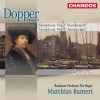传记
Cornelis 'Kees' Dopper (7 February 1870, Stadskanaal – 19 September 1939, Amsterdam) was a Dutch composer, conductor and teacher.
Born in the northern Dutch town of Stadskanaal, he came to study at the Leipzig conservatory with, among others, Carl Reinecke. After his studies he settled in Groningen, not far from his place of birth. His first opera, De blinde van Castel Cuillé (The Blind Girl of Castel Cuillé) was premiered in Amsterdam by De Nederlandse Opera under the baton of Cornelis van der Linden with some acclaim in 1894, and in that same year he entered the service of that company; here he worked as a violinist, chorus master and conductor.
During the years 1904–1905 he worked as a music critic for the Amsterdam newspapers De Echo (The Echo) and Het Leven (The Life). A year later, Dopper joined the Savage Opera Company and began to tour the United States, Canada, and Mexico. In that capacity, he was responsible for the American premiere of Puccini's Madama Butterfly (1906). He subsequently toured the country with that opera for two seasons ('06-'07 and '07-'08). Having grown tired of touring life, he returned to Amsterdam in 1908 to become second conductor of the Amsterdam Concertgebouw Orchestra, assisting the famous conductor Willem Mengelberg. He would remain there until his retirement in 1931. In recognition of his compositions, his name still decorates one of the balustrades in the Concertgebouw's great hall, between those of Debussy and Richard Strauss.
Dopper composed well over a hundred works. Because of his great love for Dutch folk song, culture and landscape, he was sometimes referred to as the 'most Dutch composer of all Dutch composers'. The titles of his symphonies attest to that sentiment: the 'Rembrandt' Symphony (No. 3, first performed on the tercentenary of Rembrandt's birth in 1906) , the 'Amsterdam' Symphony (No. 6), the 'Zuiderzee' Symphony (No. 7). Beside seven symphonies, Dopper wrote many other works for orchestra. Of these, his Ciaconna Gotica is the most famous, and is often considered to be Dopper's masterpiece. Many of his works were performed in great concert halls by famous conductors (e.g., Richard Strauss, Willem Mengelberg, Pierre Monteux and Otto Klemperer).
In addition, Dopper wrote chamber music (e.g., a string quartet, a violin sonata, and a sextet for woodwind and piano). His interest in musical education for the young caused him to write a great number of works for children's choir. In Amsterdam, Dopper introduced specific youth concerts.
Dopper died in 1939 and was buried at Zorgvlied cemetery.







